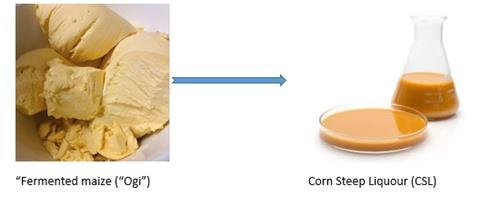Probiotic bacteria isolated from corn steep liquor - a by-product of fermented maize - can prevent E coli invasion in the mouse gut, reveals new research presented at the recent Letters in Applied Microbiology ECS Research Symposium.

The research offers hope of preventing the release of waste materials such as CSL in the environment which can result in pollution, while the probiotic, Lactiplantibacillus plantarum ROF6, can offer a good alternative to antibiotics, said Dr Racheal Fashogbon of Ajayi Crowther University in Nigeria, who presented the work.
Her presentation is entitled: ‘Evaluation of Immunomodulatory and Hematological effects of probiotic Lactiplantibacillus plantarum ROF4, 5, and 6 on diarrhea response induced by Escherichia coli in Mice.’
Fermented foods
“In recent years, consumers now take into account the specific health benefits that foods offer in addition to their nutritional requirements and personal preferences such as taste. Apart from the basic nutritional value of food, most fermented foods include a sizable quantity of health benefits,” she explained.
“One example of a fermented meal that has been demonstrated to be beneficial in treating disorders like diabetes, obesity, metabolic syndrome, heart disease, inflammatory illnesses, viral and bacterial infections, thrombosis, allergies, and diarrhea is ‘ogi’. The primary raw material used to make ogi is maize (Zea mays), one of Africa’s most important staple crops. It is inexpensive and accessible, even in rural areas, and is frequently used to eliminate hunger.
“Ogi, a fermented cereal gruel, is a smooth cereal grain with a layer of fermented water on top called Corn Steep Liquor (CSL). The Corn Steep Liquor (CSL) is a significant by-product obtained from the wet milling of fermented maize (ogi) which is typically thrown away as wastewater.

“Lactic acid bacteria (LAB), which are significant in food technology, are one of the well-known microorganisms that have been identified from cereal-based fermented foods.”
Food-borne disease
The growing number of food-borne illness outbreaks such as diarrhea caused by Escherichia coli is a significant concern for food safety and regulatory agencies, Dr Fashogbon said.
“The use of antibiotics can kill harmful and beneficial bacteria leading to digestive issues. Continuous use of antibiotics has resulted in antibiotic resistance which has led to public health concerns. The prevention and control mechanisms of foodborne illness and/or abuse of antibiotics require a multidisciplinary approach, including the consumption of probiotics LAB through fermented food, which has received increased attention over the last decades.
“Lactobacilli are found in low numbers in the small intestine of adults but some may originate from fermented foods. Rather than discarding the CSL as a waste product, it can be a potential source of probiotic LAB.”
Corn steep liquor
The researchers sourced freshly prepared CSL from fermented maize in Oyo town, Nigeria, and LAB were isolated using De-man, Rogosa, and Sharpe (MRS) agar and identified biochemically.
“The probiotic properties which include bile salt tolerance, phenol tolerance, acid resistance assay, antimicrobial test, auto-aggregation, cell surface hydrophobicity, survival in simulated gastric condition, safety evaluation (Hemolysis, antioxidant scavenging assay, DNase), enzymatic activity, antibiotic susceptibility, hematology and immunology on induced mice were carried out,” Dr Fashogbon said.
Thirty (30) mice were randomly divided into six groups (G1, G2, G3, G4, G5, and G6) of five mice per group. G1: control, placed on basal diet alone. All the other groups were also placed on basal diet, induced with 1.0 mL of 107 CFU/mL E. coli and treated with 1.0 mL of 107 CFU/mL L. plantarum strains. G2: control, Mice induced with E. coli without treatment (G2), G3: Mice induced with E. coli treated with glibenclamide (5 mg/kg) (G3), G4: Mice induced with E. coli treated with Lactiplantibacillus plantarum ROF4, G5; Mice induced with E. coli treated with Lactiplantibacillus plantarum ROF5, G6; Mice induced with E. coli treated with Lactiplantibacillus plantarum ROF6.
High survival rate
A high survival rate (78% and 88%) was observed in mice treated with L. plantarum ROF6 at 0.6% bile salt and 0.4% phenol concentration. Maximum growth of the LAB strains was observed at pH 4 and 5, and they were all gamma hemolytic. L. plantarum ROF6 exhibited the highest antagonistic effect on four pathogens (Shigella dysentriae, Staphylococcus aureus, Escherichia coli, and Klebsiella pneumonia) with inhibition zone ranging from 12.13 mm to 28.71 mm.
The strain also had the highest auto-aggregation (59.98%), hydrophobicity (82.21%), and DPPH radical scavenging activity (79%), compared to L. plantarum ROF4 and 5.
All the L. plantarum strains produced maximum amylase production of which the highest production was exhibited in L. plantarum ROF6. L. plantarum ROF4, 5, and 6 had strong susceptibility (100%) to ceftriaxone and augmentin with 100% resistance to Imipenem.
The mice treated with L. plantarum ROF4, 5, and 6 (G4-G6) had an overall increase in Hb, PCV, and RBC counts when compared to the G1, G2, and G3. The treatment group (G3 to G6) had a higher lymphocyte level than the G1 and G2. The IgG, IgA, and IgM concentrations in the serum were reduced to varying degrees in G2 and G3 when compared with G1 but highly augmented in G4-G6.
Essential traits
The results of this work revealed that L. plantarum ROF6 possesses essential traits that make it an outstanding candidate for the creation of immunobiotic functional foods, which strengthen the body’s defenses against intestinal infections.
“The amazing findings from this research are the probiotic impact of L. plantarum ROF6. This isolate improved the IgA, IgG, and IgM levels of the experimented mice (elicit immune response). It increased the weight of the induced mice and ameliorated the diarrhea in the infected mice,” Dr Fashogbon explained.
“The research has been able to prove that probiotic LAB isolated from CSL can be used to prevent E. coli invasion in the gut. This will also prevent the release of waste materials such as CSL in the environment which could result in pollution. The use of L. plantarum ROF6 can be a good alternative to antibiotics.”
Funding needed
Apart from the probiotic potentials carried out in this study, more testing needs to be done on the probiotic Lactiplantibacillus plantarum ROF4, 5, and 6 but this currently seems inaccessible due to lack of funds, Dr Fashogbon said.
“We intend to do further probiotic analyses such as adhesion to Caco-2 cells, cholesterol assimilation, and cytokine evaluation (IL-1α, IL-6, IL-8, and TNFα), to check how strong the probiotic potential of the LAB isolates. If possible, this probiotic LAB can be transformed into a form of starter culture and tablets for easy consumption and administration.”
The study was led by Dr Racheal Oluwayemisi Fashogbon and fellow team members. The Letters in Applied Microbiology Early Career Scientist Research Symposium was held at University of the West of England (UWE) in Bristol, UK, on 15 May 2024. To find out more about upcoming AMI events, visit the event page.
Topics
- Ajayi Crowther University
- Antimicrobial Resistance
- Antimicrobials
- Applied Microbiology International
- Bacteria
- Community
- Corn Steep Liquor
- Early Career Research
- Escherichia coli
- Food Security
- lactic acid bacteria
- Lactiplantibacillus plantarum
- Middle East & Africa
- One Health
- Probiotics, Prebiotics & Synbiotics
- Racheal Fashogbon
- Starter Cultures in Fermentation
- UK & Rest of Europe







No comments yet